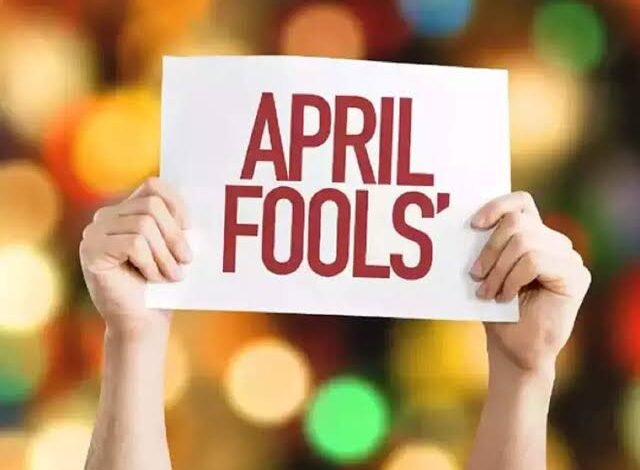April Fools’ Day: Clicks, Clowns, and Consequences

By Ibraheem Muhammad Mustapha
April Fools’ Day, observed annually on April 1st, is a time-honored event characterised by pranks, jokes, and hoaxes. What began centuries ago as a lighthearted day of jesting has grown into a global phenomenon, with individuals and organisations alike taking advantage of the opportunity to play tricks on friends, relatives, and even the general public.
However, despite the laughter and merriment, there is a darker aspect to this seemingly innocuous tradition: a link to the ubiquitous problem of disinformation in the digital era. In today’s world, where information spreads at the speed of light across the vast expanse of the internet, the line between fact and fiction has become increasingly blurred. Hence, the uncertainty caused by the deluge of information in which we are submerged has necessitated a collective reconsideration of the April Fools’ ritual.
In this article, we dive into the history of April Fools’ Day, exploring its origins and evolution into a day of whimsical trickery. We examine some of the most memorable pranks throughout history, from the legendary “Spaghetti Tree” hoax to YouTube’s infamous 2013 prank announcing its closure. Along the way, we analyze the impact of these hoaxes on individuals and society in the digital age, shedding light on the social repercussions of falling victim to misinformation.
A Journey Through Time: The Origins and Evolution of April Fools’
The origins of April Fools’ Day are shrouded in the mists of time, with various theories tracing its roots back to ancient customs and cultural traditions. One popular belief suggests that the observance dates back to the adoption of the Gregorian calendar in the 16th century when New Year’s Day was moved from late March to January 1st. Those who continued to celebrate the new year in April were dubbed “April fools” and subjected to ridicule and pranks by their peers.
However, the association of April 1st with mischief and merriment predates the Gregorian calendar reform and can be found in earlier customs and festivals. For instance, ancient Roman festivals like Hilaria, dedicated to the goddess Cybele, involved masquerades and revelry akin to modern-day April Fools’ celebrations. In medieval Europe, the Feast of Fools was a raucous festival held around the start of April, during which commoners would mock and mimic their social superiors in a topsy-turvy display of subversion. Similarly, the French tradition of “Poisson d’Avril” (April Fish) involved pinning paper fish onto unsuspecting victims’ backs.
Over time, April Fools’ Day evolved into a day of playful pranks and hoaxes, with newspapers, media outlets, tech companies, giants and dwarfs, and individuals embracing the opportunity to engage in elaborate trickery.
The Pranks Heard Round the World
Throughout history, April Fools’ Day has witnessed a plethora of ingenious and entertaining pranks that have captured the public’s imagination and left a lasting impression. Among the vast array of hoaxes, certain pranks stand out as enduring favorites, cherished for their creativity, humor, and sheer audacity. One such beloved April Fool’s prank took place in 1957 when the BBC aired a segment on its popular current affairs program, “Panorama,” announcing an extraordinary event: the annual spaghetti harvest in Switzerland. The segment, narrated with deadpan seriousness by respected broadcaster Richard Dimbleby, featured footage of Swiss farmers harvesting spaghetti from trees in the Alps.
The footage showed women carefully plucking strands of spaghetti from branches and placing them in baskets, while Dimbleby explained how a mild winter had led to an abundant spaghetti crop. The segment even included a recommendation to viewers on how to cultivate their own spaghetti trees, advising them to place a sprig of spaghetti in a tin of tomato sauce and hope for the best. The prank was executed with such skill and subtlety that many viewers were taken in by the ruse, calling the BBC to inquire about how they could obtain their own spaghetti trees. Others wrote letters expressing admiration for the innovative farming techniques showcased in the segment.
Tech Titans and Trolls: April Fools’ on the Internet Frontier
In the digital realm, April Fools’ takes on a new dimension as tech giants and online communities vie for attention with outlandish pranks and playful stunts. YouTube’s 2013 prank stands out as a prime example of this tradition. On April 1st, 2013, the video-sharing platform unveiled a prank that left users simultaneously amused and bewildered: the announcement of YouTube’s impending closure. The prank, presented through a mock press conference video, featured prominent YouTube personalities and executives bidding farewell to the platform. They cited various reasons for the decision, including the overwhelming influx of videos uploaded every minute and the impossibility of choosing a winner for the “Best Video on YouTube” contest, ultimately concluding that YouTube was simply an elaborate experiment that had run its course.
However, as the day unfolded and the realization dawned that YouTube’s closure was nothing more than an elaborate prank, the mood shifted from confusion to appreciation for the platform’s playful sense of humor. Users flooded social media with memes and reactions, showcasing their admiration for YouTube’s audacious prank and their relief that the beloved platform was here to stay.
Google also, has since its inaugural prank in 2000, continually raised the bar with increasingly elaborate and ambitious hoaxes. However, one particular prank from 2004 stands out as both legendary and groundbreaking – the launch of Gmail on April 1st. At first glance, the announcement of Gmail seemed too good to be true. Offering a staggering one gigabyte of free storage for email at a time when competitors like Hotmail and Yahoo Mail offered a mere fraction of that amount, Gmail sounded like the stuff of dreams. Many, even tech-savvy individuals, dismissed it as an elaborate hoax, especially given the whimsical tone of the announcement and the seemingly improbable nature of the offering.
From Pranks to Panic: April Fools’ in Misinformation Era
As April Fools’ Day dawns in the digital era, the line between harmless jests and harmful misinformation has become increasingly blurred and every day feels like April Fools’ Day. In a landscape where every click has the potential to spread confusion and chaos, navigating the minefield of April Fools’ pranks requires a discerning eye and a healthy dose of skepticism.
In the age of social media, the virality of jokes poses a significant risk, as satire and parody can be mistaken for genuine news stories, spreading like wildfire across online platforms. Take, for example, the case of Pluto’s planetary status. In 2006, the International Astronomical Union redefined Pluto as a “dwarf planet,” a decision that remains unchanged to this day. However, in April 2017, an article from Futurism.com falsely claimed that Pluto had been reinstated as a full-fledged planet, attributing the change to the IAU. Despite the article’s intention as a joke, its misleading content was shared and reshared, leading to confusion among readers.
In 2017, amidst growing concerns over the proliferation of fake news and coincidentally, the year “fake news” made it to the word of the year of dictionary publisher Collins, a handful of Scandinavian newspaper editors made a bold decision: they would no longer publish April Fools’ stories. Magnus Karlsson, editor of the Swedish daily paper Smalandsposten, succinctly captured their sentiment: “We work with real news.” This move reflected a broader acknowledgment of the potential harm that April Fools’ jokes could inflict in an era where misinformation spreads like wildfire.
Meanwhile, tech giant Google, known for its elaborate April Fools’ pranks, announced in 2020 that it would abstain from the tradition. Recognizing the gravity of the COVID-19 pandemic and the prevalence of misinformation surrounding the virus, Google opted to prioritize its role in disseminating accurate information. In an internal email to staff, the company expressed its commitment to being helpful to people during a time of crisis, deferring the jests to a brighter future.
This departure from the traditional spirit of April Fools’ Day was not limited to media outlets and tech companies. Reuters reported in 2020 on governmental responses to April Fools’ Day pranks related to the coronavirus. Countries like Thailand and India took decisive action to discourage the spread of rumors and falsehoods that could endanger lives. Some went as far as threatening jail time for individuals who engaged in COVID-19 related April Fools’ pranks, recognizing the potential harm such misinformation could cause in the midst of a public health crisis.
These developments reflect a broader shift in societal attitudes towards April Fools’ Day and the role of humor in the digital age. As misinformation continues to permeate online spaces and pose tangible risks to individuals and communities, there is a growing recognition of the need for responsibility and discernment in the dissemination of information, even in the context of lighthearted jesting.




